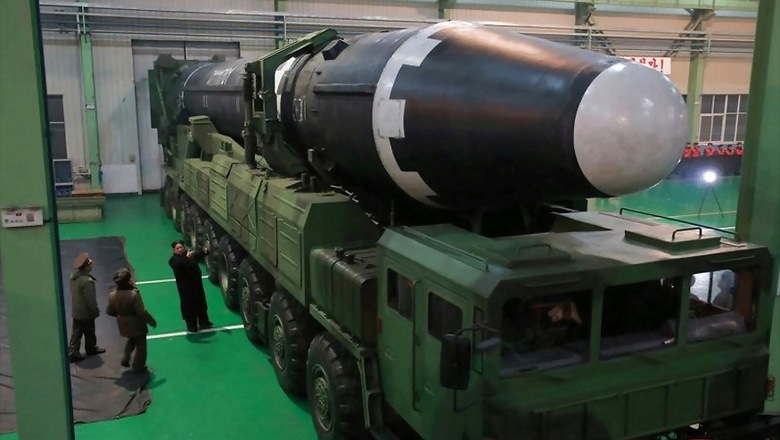
views
Washington/ Seoul: Images released by North Korea on Thursday appeared to show it has succeeded in developing a missile capable of delivering a nuclear weapon anywhere in the United States and it could be only two or three tests away from being declared combat ready, U.S.-based experts said on Thursday.
North Korea released dozens of photos and a video after Wednesday's launch of the new Hwasong-15 missile, and leader Kim Jong Un declared the country had "finally realized the great historic cause of completing the state nuclear force".
U.S.-based experts, some of whom have been sceptical about past North Korean claims to have put all of the United States in range, said data from the latest test and the photos appeared to confirm North Korea has a missile of sufficient power to deliver a nuclear warhead anywhere in America.
Experts and U.S. officials say questions remain about whether it has a re-entry vehicle capable of protecting a nuclear warhead as it speeds toward its target and about the accuracy of its guidance systems.
In an analysis for the Washington-based 38 North think tank, missile expert Michael Elleman of the International Institute for Strategic Studies said the North Korean photos showed a missile considerably larger than its predecessor.
"Initial calculations indicate the new missile could deliver a moderately sized nuclear weapon to any city on the U.S. mainland," Elleman said.
Elleman said the missile was large and powerful enough to carry simple decoys or other countermeasures to challenge U.S. missile defences.
"A handful of additional flight tests are needed to validate the Hwasong-15's performance and reliability, and likely establish the efficacy of a protection system needed to ensure the warhead survives the rigors of atmospheric re-entry," Elleman wrote.
Only two or three more tests might be needed if North Korea could accept low confidence in the missile's reliability.
Another missile expert, whose employer does not allow him to speak publicly to the media, agreed with Elleman's assessment.
"If North Korea does not make high demands on the reliability or accuracy of the missile ... two or three more tests would suffice.
"So long as North Korea can hit U.S. cities with thermonuclear warheads, they probably don't need the ability hit every city they target or target specific aim points within those cities to convince the U.S. leadership that war with North Korea would be too expensive to contemplate."
In a call with U.S. President Donald Trump on Thursday, South Korean President Moon Jae-in said the missile was North Korea's most advanced so far. But it was unclear if Pyongyang had the technology to miniaturise a nuclear warhead, and it still needed to prove other things, including re-entry technology.
U.S. based experts said North Korea had almost certainly developed a warhead light enough to be carried by the Hwasong- 15, which Elleman said should be capable of delivering a 1,000 kg payload.
LARGER, MORE POWERFUL
Jeffrey Lewis of the Middlebury Institute of Strategic Studies said on Twitter the Hwasong-15 was "so big that the warhead wouldn’t need to be miniaturised."
On Wednesday, U.S. Defense Secretary Jim Mattis acknowledged the missile went higher than any previous test and was part of a North Korean effort "to continue building ballistic missiles that can threaten everywhere in the world, basically."
North Korea said the missile soared to an altitude of about 4,475 km (2,780 miles), more than 10 times the height of the International Space Station, and flew 950 km (590 miles) during its 53-minute flight before landing in the sea near Japan.
The missile's large size was immediately apparent in the photos, which analysts said allowed for a more powerful propulsion system.
"This is a very big missile," said Michael Duitsman, a research associate at the Centre for Nonproliferation Studies. "And I don't mean 'big for North Korea.' Only a few countries can produce missiles of this size, and North Korea just joined the club."
U.S. experts and officials said the missile still appeared to be powered by liquid fuel, something that made it vulnerable as it could take to up to two hours to fuel on-site before launching.
Earlier, one U.S. official told Reuters the missile could have been powered by solid fuel, but experts said North Korea could still be a few years away from being able to field a more versatile solid-fuelled ICBM.
The photos appeared to show the missile with at least two large nozzles on its first stage, instead of the one large and several smaller nozzles on the Hwasong-14.
"The first stage seems to use essentially the same case (as the Hwasong-14) but has two engines," said David Wright, of the Union of Concerned Scientists, a U.S.-based nonprofit science advocacy group. "The second stage looks like it can carry more than twice as much propellant. The combination of those two things means it really is a new, more capable missile."
While the photos show a mobile erector vehicle being used to position the missile upright, it is not seen in photos of the launch itself. U.S. intelligence analysts have concluded that the test missile was fired from a fixed position, not a mobile launcher, three U.S. officials said.
The massive vehicle was "100 percent" a domestic product of North Korea, state media quoted Kim Jong Un as saying.
Western analysts said it is more likely the truck was one of about half a dozen vehicles obtained years ago from China, which North Korea has modified since then.
















Comments
0 comment